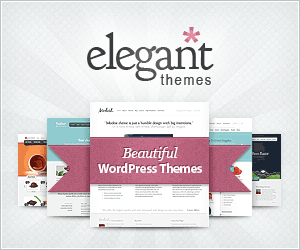As cross-platform mobile app development continues to evolve, developers and businesses face an increasingly complex decision when choosing the right framework for their projects. In 2024, two of the most prominent contenders in this space are Flutter and React Native, each boasting distinct advantages and capabilities that cater to diverse development needs.
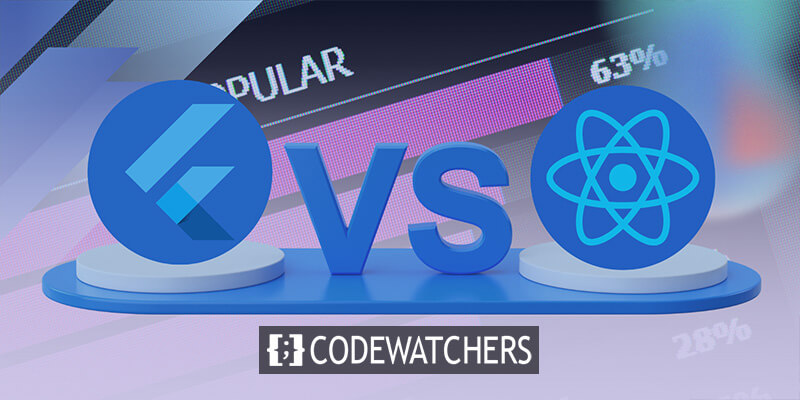
Flutter, developed by Google, has gained considerable traction due to its expressive UI components and seamless platform performance. It is an appealing choice for those looking to deliver visually captivating applications. On the other hand, React Native, backed by Facebook, has established a strong reputation for its ability to leverage existing JavaScript libraries and facilitate rapid development cycles, attracting a vast community of developers.
This article delves into a comprehensive comparison of Flutter and React Native, examining their core features, performance metrics, ecosystem support, and overall developer experience in the context of 2024 in the cross-platform app development arena. By analyzing the strengths and weaknesses of each framework, we aim to provide valuable insights for developers and organizations seeking to make informed decisions that align with their technological goals and project requirements in the ever-competitive cross-platform mobile application landscape.
What Is Flutter?
Flutter is an open-source UI software development kit created by Google. It allows developers to build natively compiled mobile, web, and desktop applications from a single codebase. Using the Dart programming language, Flutter offers a rich set of pre-designed widgets and tools for creating beautiful, responsive user interfaces.
Create Amazing Websites
With the best free page builder Elementor
Start Now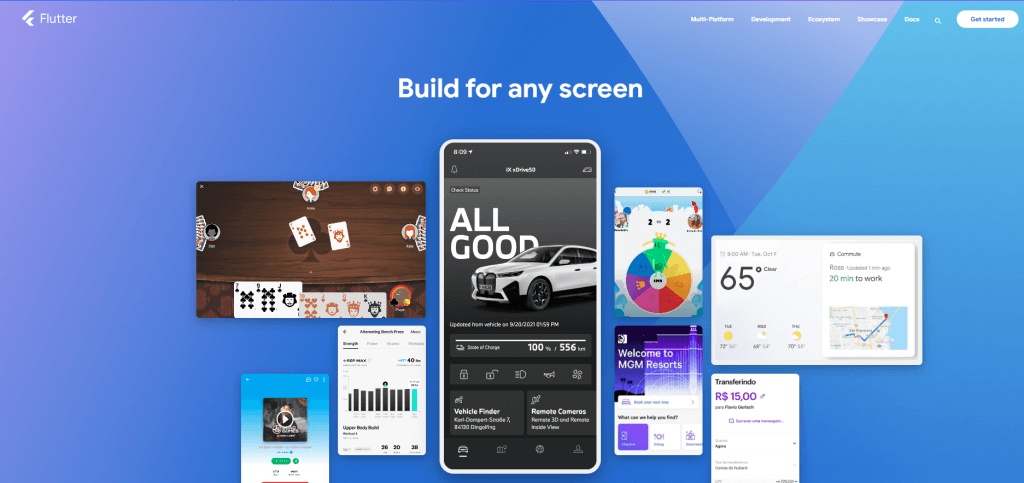
Key features include:
- Hot reload for quick development
- Custom, flexible UI design
- Native performance on various platforms
- Extensive, active community support
Flutter's popularity stems from its ability to streamline cross-platform development, reduce time-to-market, and maintain a consistent look across devices. Whether you're building a startup MVP or a complex enterprise app, Flutter provides a robust framework for efficient, scalable app development.
User base
Flutter has gained significant traction since its release, with a growing user base among individual developers and large corporations. As of 2024, it's one of the most popular cross-platform mobile development frameworks.
Some prominent companies using Flutter include:
- Google (creator of Flutter)
- Alibaba
- BMW
- eBay
- Tencent
- Grab
- Nubank
- Philips Hue
- The New York Times
- Square (Block, Inc.)
These companies have used Flutter for various applications, from e-commerce and finance to automotive and IoT control. Google itself uses Flutter in several of its products, including Google Ads and Google Pay.
Advantages
There are a lot of advantages of using Flutter. Some of them go by -
- Cross-platform development: Flutter allows developers to create cross-platform apps for multiple platforms (iOS, Android, web, desktop) using a single codebase, saving time and resources.
- Fast development: Flutter's hot reload feature lets developers see changes instantly, speeding up the development process and allowing for quick iterations.
- Consistent design: Flutter's widget-based architecture ensures a consistent look across platforms, maintaining brand identity and user experience.
- Performance: Flutter compiles to native code, resulting in near-native performance on different platforms.
- Custom, attractive UI: Flutter provides a rich set of customizable widgets and tools for visually appealing interfaces.
- Large and growing community: A supportive community contributes to many packages, plugins, and resources.
- Cost-effective: Developing one codebase for multiple platforms reduces development and maintenance costs.
- Integration with native features: Flutter allows easy access to platform-specific features and third-party SDKs.
- Backed by Google: Continuous updates and support from Google ensure long-term viability and improvement.
- Learning curve: Dart, Flutter's programming language, is relatively easy to learn, especially for developers familiar with object-oriented programming.
Disadvantages
While Flutter offers many advantages, it also has some disadvantages. Here are the key drawbacks of using Flutter:
- Larger app size: Flutter apps tend to be larger than native apps due to the inclusion of the Flutter engine and framework.
- Limited native functionality: Some platform-specific features may require additional plugins or native code integration.
- Relatively new technology: Being newer than some alternatives, Flutter may have fewer third-party libraries and tools compared to more established frameworks.
- Learning curve for Dart: Developers unfamiliar with Dart may need time to learn the language, although it's generally considered easy to pick up.
- iOS-specific challenges: Flutter can sometimes lag in supporting the latest iOS features, and achieving a fully native iOS look can be challenging.
- Limited TV and wearable support: Flutter's support for TV platforms and wearables is still developing and may not be as robust as for mobile and web.
- Web performance concerns: While improving, Flutter web apps may not perform as well as those built with web-specific technologies for complex applications.
- Potential for inconsistent updates: Rapid development of Flutter can sometimes lead to breaking changes or deprecations that require code updates.
- Less mature ecosystem: Compared to native development, Flutter's ecosystem of tools, IDEs, and CI/CD processes is still maturing.
- Potential overreliance on third-party packages: Developers may need to rely on community-created packages for some functionality, which can introduce quality and maintenance concerns.
When to Use
The framework is trendy among startups and small to medium-sized businesses due to its cost-effectiveness and rapid development capabilities. However, it's also increasing adoption in larger enterprises for customer-facing apps and internal tools.
Flutter's use case spans across industries, including:
- E-commerce
- Finance and banking
- Travel and hospitality
- Health and Fitness
- Entertainment and media
- Education
- IoT and smart home
The growing adoption by major industry players has helped solidify Flutter's position as a mainstream development framework.
What Is React Native?
React Native is an open-source mobile application development framework created by Facebook. It allows developers to build mobile apps for both iOS and Android platforms using JavaScript and React, a popular web development library. React Native translates your code into native app development components, resulting in a truly native mobile app experience.
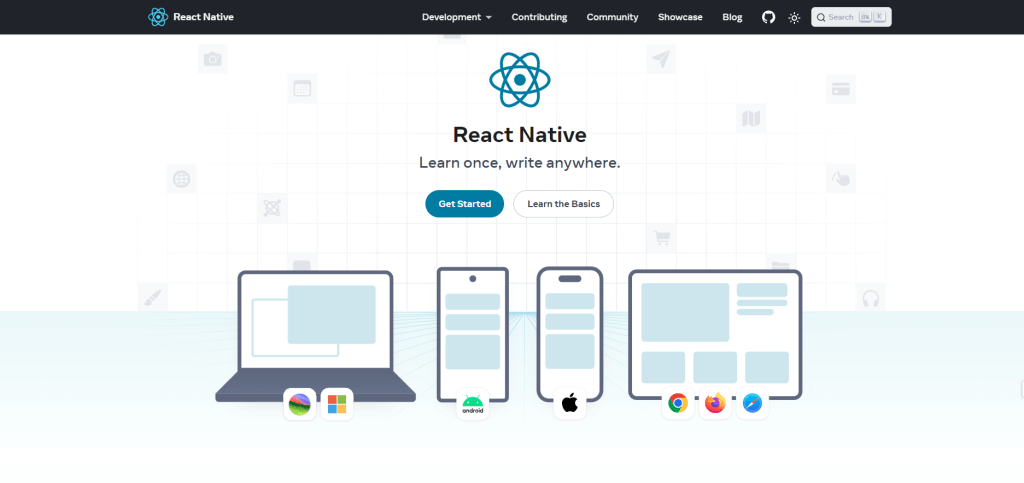
Key features include:
- Cross-platform development
- Reusable components
- Hot reloading for faster development
- Access to native app development platform features
- Large community and ecosystem
React Native's "learn once, write anywhere" philosophy enables developers to create mobile apps with a native framework look and feel while leveraging their existing web development skills. It's widely used by companies like Facebook, Instagram, and Airbnb to build high-performance, visually appealing mobile applications.
User base
React Native has gained significant popularity since its release, with a large and diverse user base. Here's an overview of its adoption and some notable companies using it:
React Native is widely used by both individual developers and large corporations. It's prevalent among companies looking to maintain a single codebase for iOS and Android platforms.
Some prominent companies using React Native include:
- Facebook (creator of React Native)
- Walmart
- Bloomberg
- Airbnb (though they've since moved away from it for their main app)
- Discord
- Uber Eats
- Shopify
- Microsoft (for some of their apps)
The framework's large community contributes to a rich ecosystem of third-party libraries and tools, further enhancing its appeal to developers and companies.
Advantages
React Native offers several compelling advantages for mobile app development. As a framework that bridges the gap between web and mobile development, it has become a go-to choice for many developers and companies seeking efficient cross-platform solutions. Let's explore the key benefits of using React Native:
- Cross-platform development: Developers can write code once and deploy on iOS and Android, significantly reducing development time and costs.
- Code reusability: A large portion of the codebase can be shared between platforms, with only minor platform-specific adjustments needed.
- Native performance: React Native compiles native code, offering performance close to fully native apps.
- Faster development: The hot reloading feature allows developers to see changes instantly, speeding up the development process.
- Extensive community and ecosystem: A vast community of developers contributes to a rich ecosystem of libraries, tools, and resources.
- Familiar technology stack: Web developers can leverage their existing JavaScript and React skills to build mobile apps.
- Cost-effective: Maintaining a single codebase for multiple platforms reduces overall development and maintenance costs.
- Third-party plugin support: Easy integration with both native modules and third-party plugins enhances functionality.
- Live updates: Some app updates can be pushed to users without going through the app store approval process.
- Open-source: Being open-source, React Native benefits from continuous improvements and contributions from the developer community.
Disadvantages
While React Native offers numerous benefits, it's essential to consider its limitations and potential drawbacks. As with any technology, React Native has its share of challenges that developers and businesses should be aware of when deciding on a mobile app development framework. Here are the main disadvantages of using React Native:
- Performance limitations: For highly complex or graphics-intensive apps, React Native may not match the performance of fully native development.
- Native module dependencies: Some advanced features require native modules, which can complicate development and maintenance.
- Fragmentation issues: Keeping up with updates for both iOS and Android platforms can be challenging, potentially leading to inconsistencies.
- Larger app size: React Native apps tend to be larger than their native counterparts due to the included JavaScript runtime.
- Learning curve for native developers: Native iOS and Android developers must learn JavaScript and React paradigms to work effectively with React Native.
- Limited access to native APIs: Not all platform-specific APIs are immediately available, sometimes requiring custom native modules.
- UI inconsistencies: Achieving a fully native look and feel across both platforms can be challenging and may require platform-specific code.
- Debugging challenges: Debugging can be more complex, especially when dealing with issues at the bridge between JavaScript and native code.
- Potential for breaking changes: Rapid development of React Native can sometimes lead to breaking changes in new versions, requiring code updates.
- Third-party library quality: Reliance on third-party libraries can introduce quality and maintenance concerns, as not all are well-maintained.
When to Use
React Native is used across various industries, including:
- Social media and communication
- E-commerce
- Finance and banking
- Travel and hospitality
- News and media
- Productivity tools
Its popularity stems from the ability to leverage web development skills for mobile app creation, faster development cycles, and cost-effectiveness in cross-platform development.
Many startups and small to medium-sized businesses choose React Native for its ability to quickly deploy on both major mobile platforms with a single team. However, it's also found favor among larger enterprises for both customer-facing apps and internal tools.
Flutter vs. React Native: An In-Depth Comparison
When choosing a framework for developing cross-platform app development, Flutter and React Native stand out as leading contenders. Both offer powerful tools for creating high-quality, performant apps for iOS and Android, but they differ significantly in their approach, capabilities, and ecosystems. This comprehensive comparison will help you navigate the nuances of each framework to make an informed decision for your project.
1. Technology Stack
Flutter:
- Developed by Google, Flutter leverages the Dart programming language, a modern, object-oriented language designed for client-optimized apps.
- Flutter developers architect Dart code directly to native ARM or x86 machine code, eliminating the need for a bridge and potentially boosting performance.
- The framework provides a rich set of customizable widgets and a reactive approach to UI building, allowing for highly flexible and expressive user interfaces.
- Flutter's "everything is a widget" philosophy promotes a consistent, composable approach to UI development.
React Native:
- Created by Facebook, React Native builds upon the popular React library, utilizing JavaScript and JSX (a syntax extension for JavaScript) for development.
- It employs a bridge to communicate between JavaScript and native components, which can impact performance but allows easy integration with existing native code.
- React Native follows a "learn once, write anywhere" philosophy, allowing web developers to leverage their existing JavaScript and React skills.
- The framework's use of native components ensures a look and feel consistent with the platform's design guidelines.
2. Performance
Flutter:
- Flutter's compilation to native code often results in superior performance, especially for animation-heavy apps or games.
- The framework's use of the Skia graphics engine allows for smooth 60fps animations on most devices.
- Flutter's hot reload feature speeds up development and maintains the app's state during code changes, enhancing the debugging experience.
- The framework's ability to control every pixel on the screen can lead to more consistent performance across different devices.
React Native:
- While React Native performs well, complex apps may experience occasional jank due to the JavaScript bridge.
- The framework's native components can improve performance in specific scenarios, especially with platform-specific features.
- React Native's hot reloading capability and modular architecture allow for rapid iteration and testing of UI changes.
- Performance optimization in React Native often requires more manual intervention, such as moving computationally intensive tasks to native modules.
3. Ecosystem and Community
Flutter:
- Flutter's ecosystem has grown exponentially with pub.dev is now hosting thousands of packages and plugins.
- Google's strong backing includes extensive documentation, codelabs, and video tutorials, making it easier for newcomers to get started.
- The Flutter community is known for its enthusiasm and helpfulness, with active forums, local meetups, and many conferences dedicated to the framework.
- Flutter's integration with Firebase and other Google services is seamless, offering a comprehensive suite of backend and analytics tools.
React Native:
- React Native boasts a mature ecosystem with a vast array of third-party libraries, many of which have been battle-tested in production environments.
- The framework benefits from the broader React and JavaScript ecosystems, giving developers access to many tools and libraries.
- Facebook's continued investment ensures regular updates and improvements, including recent initiatives like the new architecture and Fabric renderer.
- The React Native community is large and diverse, with contributions from major companies and individual developers, resulting in a rich ecosystem of tools and best practices.
4. Platform Support and Compatibility
Flutter:
- Flutter's support extends beyond mobile, with stable web and desktop development channels, allowing for truly cross-platform applications from a single codebase.
- The framework's custom rendering engine ensures consistent behavior across Android and iOS versions, minimizing platform-specific issues.
- Flutter's support for older OS versions (Android 4.1+ and iOS 8+) allows developers to target a broad user base without sacrificing modern features.
React Native:
- While primarily focused on mobile, React Native has community-driven initiatives for web (React Native Web) and desktop (React Native Windows and macOS) development.
- The framework's use of native components ensures that apps automatically adapt to platform updates, maintaining consistency with the latest OS design guidelines.
- React Native's support for older OS versions (Android 4.1+ and iOS 10+) is slightly more limited than Flutter's but still covers most devices in use.
Challenges of Flutter and React Native
Both Flutter and React Native face some similar challenges in the cross-platform development framework space:
- Keeping up with platform changes: Both frameworks must constantly update to support the latest features and changes in iOS and Android platforms.
- Achieving native look and feel: While both frameworks strive to provide a native user experience, it can be challenging to perfectly replicate the look and feel of native apps, especially for platform-specific UI components.
- Testing complexity: Testing cross-platform apps requires consideration of multiple devices, OS versions, and screen sizes, increasing the complexity of the QA process.
- Hot reload limitations: While both offer hot reload features, complex state changes or certain updates may still require a full app restart.
- The learning curve for native developers: Developers with experience in native iOS or Android development may face a learning curve when transitioning to these cross-platform popular frameworks.
By understanding these challenges, developers can better prepare for cross-platform development and make informed decisions when choosing between Flutter and React Native for their projects.
Flutter vs React Native: A Popularity Showdown
Flutter and React Native have emerged as two titans, each vying for developers' attention and adoption. Let's dive into the current state of their popularity and what it means for the future of mobile app development.
GitHub Stars and Contributors

One way to gauge popularity is by looking at GitHub metrics:
- React Native: Over 105,000 stars and 2,500+ contributors
- Flutter: Over 150,000 stars and 1,000+ contributors
While Flutter leads in stars, React Native has a more extensive contributor base, indicating strong community support for both frameworks.
Job Market Demand
According to job posting data:
- React Native job listings have been consistently high over the past few years
- Flutter job postings have shown significant growth but still lag behind React Native
This suggests that while Flutter is gaining traction, React Native still dominates in industry adoption.
Developer Surveys

The Stack Overflow 2024 Developer Survey provides interesting insights:
- React Native was used by 9% of respondents
- Flutter was used by 9.4% of respondents
This shows Flutter slightly edging out React Native in usage among developers surveyed.
Google Trends
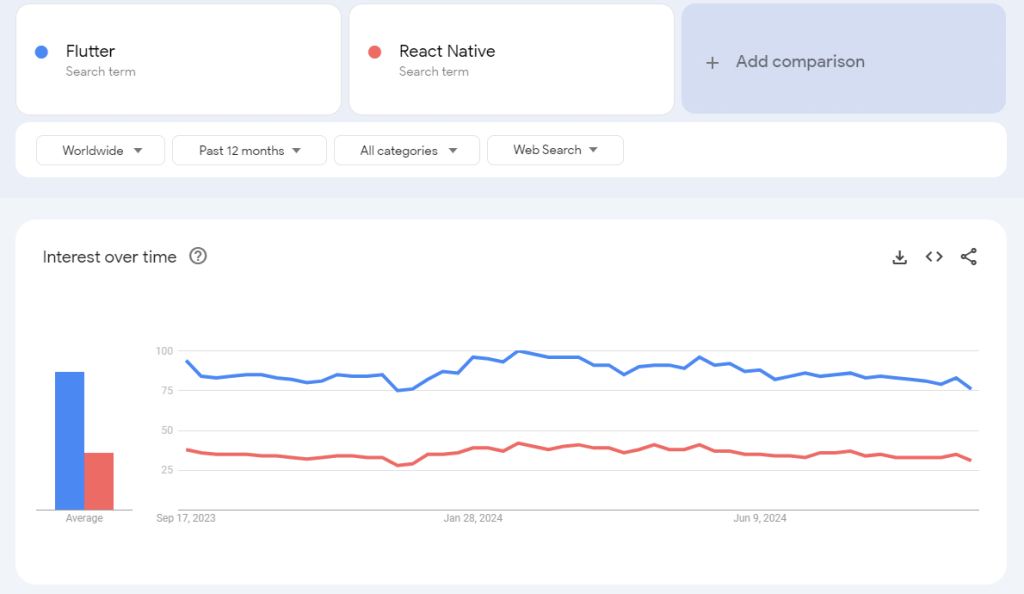
Google Trends data over the past five years shows:
- React Native has maintained a steady level of interest
- Flutter has seen a sharp rise in search interest, overtaking React Native.
This indicates growing curiosity and adoption of Flutter among developers.
Flutter vs React Native - Future
It is evident that the IT world is evolving every day, and it's hard to forecast the future of certain items. However, we could depend on specific trends that have already been established. Let's look and try to answer the question, "Will Flutter replace React Native?"
Hybrid App Dominance
Frameworks for cross-platform development, such as React Native and Flutter, continued to be popular as companies tried to design more effective applications on the iOS and Android platforms.
Competition and Innovation
The battle between React Native and Flutter spurred the development of both frameworks. Every update introduced new features, enhancements, and tools.
Adoption by Enterprises
Large companies use two frameworks, Flutter and React Native, to develop mobile apps that showcase the frameworks' capabilities for the enterprise.
Frequent Updates
Updates and updates from both communities highlighted the ongoing support and development efforts.
Conclusion
We're sure Flutter won't kick out React Native in a big fight called "Flutter vs. React Native 2024," but it will continue to do well over the next few years. However, we don't know the answer to the question, "Will Flutter replace React Native?"
Until 2023, the development teams kept adding new features and making changes. This will happen again in 2024 and 2027. Let's wait for the latest features, changes, and anything else React Native and Flutter may bring.
Frequently Asked Questions
Is Flutter better than React Native?
Ans: For a while, Flutter has been slowly becoming more popular than React Native. This is because it's thought to be easier to use. Also, there are many more fixes for problems mentioned on Flutter's GitHub than on React Native's. Unfortunately, there aren't many Flutter developers, which is a big problem. There are many reasons why Flutter is better than React Native, but it's hard to say which is better for making close-to-native mobile apps.
Is Flutter faster than React Native?
Ans: After changes were made to React Native's architecture (JSI), its speed has been getting more like Flutter. However, a Flutter app might still be faster than a React Native app. This doesn't have to be a problem; it depends on the product and what it does.
Is Flutter ready for production in 2024?
Ans: Flutter has been ready for use for a long time. Developers can use the tool to make Flutter framework apps run on desktops, phones, and the web with a single codebase.
Is flutter native or hybrid?
Ans: To make mixed or cross-platform mobile apps with native app development elements, you can use the Flutter SDK.
Does Flutter work with AI?
AI is possible with Flutter, and developers can use it to make custom features that reply to user queries in real-time. We even made an open-source Mistral AI API driver for Flutter, which you can get here. We also have a complete, step-by-step guide that shows how to use AI in four different ways in mobile apps.


